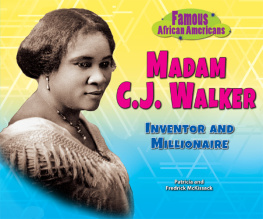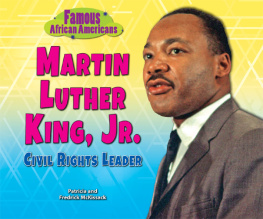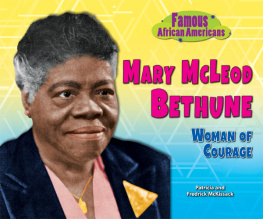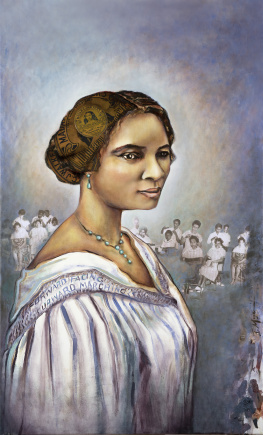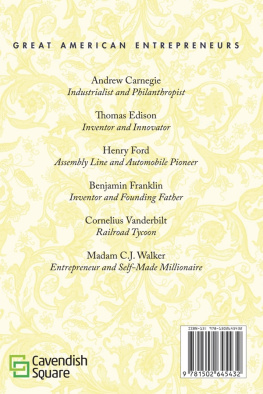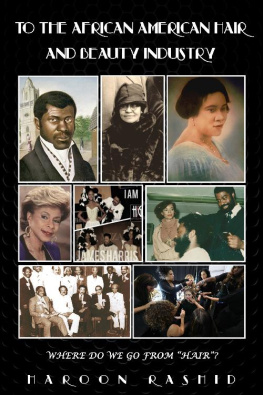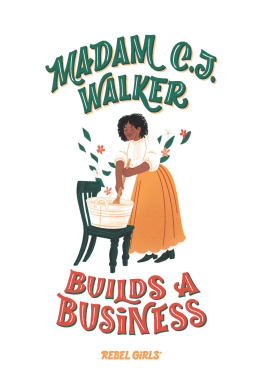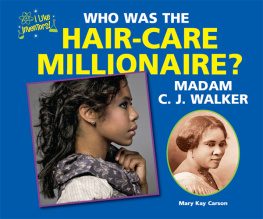SELF-MADE MILLIONAIRE
WHEN MADAM C.J. WALKER COULD NOT FIND A PRODUCT TO HELP HER HAIR LOOK HEALTHY, SHE CREATED HER OWN! SHE HELPED AFRICAN-AMERICAN WOMEN KEEP THEIR HAIR AS HEALTHY AND BEAUTIFUL AS HERS. READ ABOUT MADAM C.J. WALKERS LIFE IN THE FAMOUS AFRICAN AMERICANS SERIES.
ABOUT THE AUTHORS

Patricia and Fredrick McKissack have written over one hundred books about the African-American experience. They have won countless awardsincluding the Coretta Scott King Awardand received much critical acclaim, all the while bringing enjoyment and information to young readers.

Image Credit: Michael Bryant
Many freed slaves in the South worked in the same fields they had worked in when they were slaves.
Before the Civil War, Owen and Minerva Breedlove were slaves. They worked in the cotton fields on a large Louisiana plantation. When the war ended in 1865, so did slavery. Millions of African Americans were freed, including the Breedloves and their children, Louvenia, Alexander, James, and Owen Jr.
Freedom was just about all the family had. Owen and Minerva did not have money, jobs, or a home. All they knew how to do was farm. But they had no land.
The Breedloves did what many other slaves did. They became sharecroppers. They rented land from their old master and farmed it. Owen and Minerva worked long, hard hours on their rented farm. Still they stayed poor. Most of what they earned went to pay back the landowner for seeds and food. There was no way to get ahead.
Owen and Minerva Breedlove were going to have another child. Christmas was not far away. There was no money for gifts. Two days before Christmas in 1867, Sarah Breedlove was born. The family called her their Christmas baby. They had high hopes for this child. She was born free!

Image Credit: Madam C. J. Walker Collection, Indiana Historical Society
Sarah Breedlove was born in this small cabin in Louisiana. She grew up to be the countrys first female self-made millionaire.

Image Credit: Michael Bryant
Sarah and her sister worked hard. They made money by washing other peoples clothes.
Life was hard for Sarah and her family. It got even worse. There were many deadly diseases. Her parents got very sick and died. By 1875, Sarah was an orphan.
Seven-year-old Sarah went to live with her married sister. Louvenia tried to take care of her as best she could. But the cotton crops failed year after year. They needed money to live.
Sarahs brother Alex decided to move across the river to Vicksburg, Mississippi. After a while, Louvenia and her husband and Sarah moved there, too. The two young women took in laundry to make a living. Soon young Sarah married Moses McWilliams so she could have a home of her own. On June 6, 1885, Sarahs daughter, Lelia, was born. About three years later, Moses died.

Image Credit: Michael Bryant
In the 1800s there were many steamboats on the Mississippi River. Sarah enjoyed watching them.
Vicksburg was a river town. Sarah watched riverboats float up and down the river. She decided it was time to move on, too. Sarah moved to St. Louis, Missouri, in 1889.
Soon Sarah had a good laundry business there. But she wondered if life would ever be better for her and Lelia.
Sarah worked hard so Lelia could go to school. Lelia was bright and enjoyed reading. Sarah sent her to Knoxville College in Tennessee. Meanwhile, Sarah wasnt happy doing laundry. She wanted to do more with her life.
In 1904, Sarah went to hear Margaret Murray Washington speak at a meeting of the National Association of Colored Women in St. Louis. Margaret Murray Washington was the wife of Booker T. Washington, the most well known black leader of the time. She gave a great speech about the rewards of hard work.
Sarah made up her mind. She was going to improve her life.
There were not many products for black womens hair problems. Sarahs hair was thin and dry. Some of it was falling out. Sarah decided to make a hair grower to use on her own hair. It worked. Her hair grew longer and thicker.
Lelia was away at college. Sarah had married again, but she divorced her husband. There was nothing keeping Sarah in St. Louis. So she moved to Denver, where her brother Owens wife and four daughters lived.
Sarah got a job in a drugstore. At night she worked on her hair products. Soon, Sarah began selling her goods from door to door. Black women were happy to have something that made their hair look nice. Sarahs sales were so good, she hired women to help sell door-to-door, too.

Image Credit: Michael Bryant
Sarah went from house to house telling women about her hair products. Soon her business started to grow.

Image Credit: Madam C. J. Walker Collection, Indiana Historical Society
Sarahs husband C.J. helped with advertising. This is an ad for some of Madam Walkers hair products.
Sarah had known Charles Joseph (C. J.) Walker back in St. Louis. Now he lived in Denver, too. Their friendship soon grew into love. On January 4, 1906, Charles and Sarah were married. From that time on, she called herself Madam C. J. Walker.

Image Credit: Library of Congress
Madam Walker trained women to have a complete look. She showed them how to care for their hair, nails, and clothing.
When Lelia graduated from college, she came to help her mother. In 1908, Madam Walker and her daughter opened Lelia College in Pittsburgh, Pennsylvania. They trained women in the Walker hair care plan. Women who graduated from the school were called hair culturists.
First the culturist washed the womans hair. Madam Walkers hair grower was added. Then the customers hair was pressed with a hot comb and curled.
In 1910, Madam Walker built her first factory in Indianapolis, Indiana. Right away she hired people to help build a strong business. Lawyers Robert Lee Brokenburr and Freeman Briley Ransom managed the company. Violet Davis Reynolds was Madam Walkers secretary and good friend. They traveled together. They showed other black women that they could start businesses, too.

